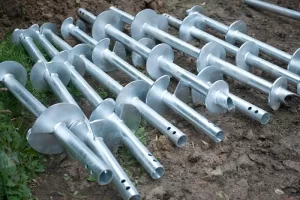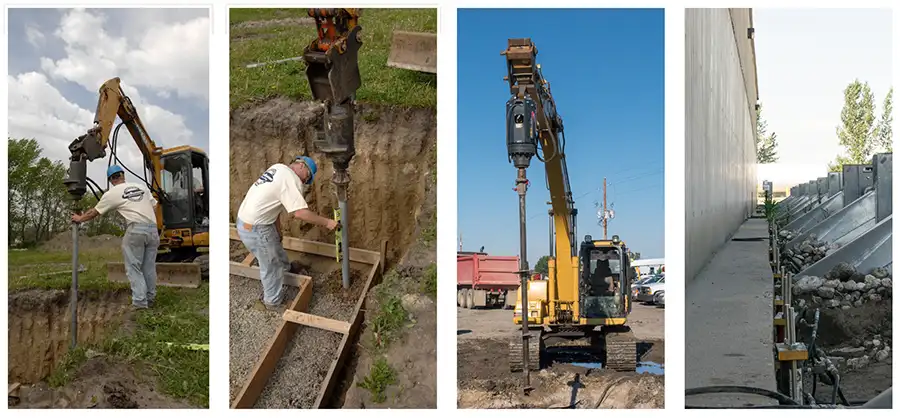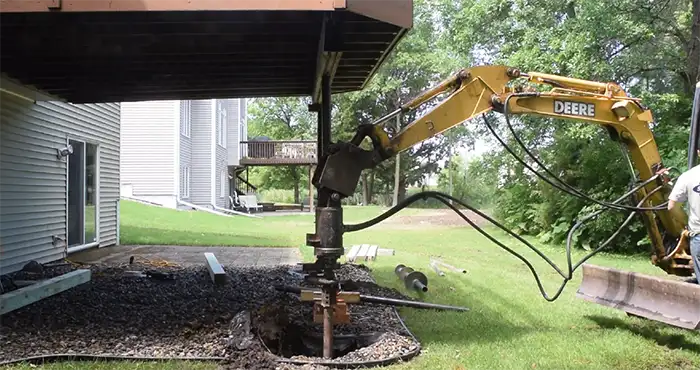Strengthening the Foundations of an Existing Home Using Helical Piers
From my experience, helical piers are a fantastic option for bolstering the foundations of older homes. They work by shifting the structure’s weight down to more stable soil layers below, which boosts the overall stability and longevity. The installation of helical piers is a testament to our expertise and precision. It involves sophisticated tools, including hydraulic drilling rigs that precisely monitor torque. This ensures that each pier is placed exactly where it needs to be to hold up the load, instilling confidence in the process’s effectiveness.
Conducting a thorough soil analysis is not just a step; it’s a commitment to ensuring the stability of your foundation. This comprehensive approach helps us determine the specifics, like shear strength and compressibility, that are critical for a successful setup, providing reassurance about the thoroughness of our process.
What I love about using helical piers is how quick and noninvasive the process can be, making it perfect for urban settings where minimal disturbance is desired.
With a potential lifespan of up to 150 years, helical piers provide more than just support, and they provide security. Their solid, long-term support ensures that your investment in foundation stability is a lasting one. If you’re curious about this technology and want to learn more, there’s much to explore!
Understanding Helical Piers
Let me tell you about helical piers, quite the game-changer in foundation solutions. We also call them helical piles, and they’re designed not only  for new builds but also for giving a solid boost to structures that need a bit more stability. The magic of helical piers lies in their ability to shift the structure’s weight to firmer soil layers deep below the surface. These piers come in various types, each crafted for different load capacities and soil conditions. Whether you go for a single-helix or a multi-helix configuration comes down to the load you expect and what the geological surveys tell us about the site.
for new builds but also for giving a solid boost to structures that need a bit more stability. The magic of helical piers lies in their ability to shift the structure’s weight to firmer soil layers deep below the surface. These piers come in various types, each crafted for different load capacities and soil conditions. Whether you go for a single-helix or a multi-helix configuration comes down to the load you expect and what the geological surveys tell us about the site.
The installation process is crucial. We use hydraulic machinery to screw these piers into the ground, ensuring precision and that everything meets engineering standards. What’s great about this method is that we can immediately test the load-bearing capacity and make any necessary adjustments. We’re not just guessing here; we rely on a mix of empirical data and mathematical models, considering factors like soil density, cohesion, and bearing capacity.
The standards we follow ensure these piers are anchored deep enough to handle the loads they need to support. This requires meticulous planning and testing because if we get the depth wrong or don’t install them properly, the foundation could be at risk of settling unevenly or even structural failure. When we understand how all these elements—pier types, installation techniques, and soil assessments—work together, we can create foundations that are both stable and long-lasting. That’s how we help extend the life of the structures they’re supporting.
Assessing Foundation Needs
When figuring out foundation needs, I like to start by taking a comprehensive look at the structure’s requirements and the soil conditions unique to each project. The first step is a solid foundation inspection to spot issues like cracks, misalignments, or signs of wear and tear. After that, I do a detailed structural evaluation to see how much weight the current foundation can handle.
A big part of this process is getting down to the nitty-gritty of soil analysis. I’m talking about checking out the soil’s composition, density, and ability to support weight. These factors can really make or break how well the foundation holds up, so having accurate data is crucial for designing helical piers that will do the job. I use advanced geotechnical testing methods to understand the soil’s shear strength and compressibility—key elements for figuring out any potential settlement issues.
Moisture is another piece of the puzzle. Different moisture levels can cause uneven settling and even structural woes. So, I measure soil moisture content and groundwater levels to foresee and tackle any moisture-related foundation problems before they become serious. Keeping an eye on these factors over time is vital to catch any patterns in settlement that might signal the need for some tweaks or repairs.
To stay ahead of the game, I incorporate settlement monitoring to track any movement in the foundation. Using precise instruments like inclinometers and settlement plates, I can get real-time data on shifts or subsidence, which means I can fix things before things get out of hand.
Installation Process Overview
Laying the groundwork for a successful installation starts with understanding the foundation needs and soil conditions. When installing helical piers, the first step is diving into a detailed soil analysis. This helps us figure out the best techniques to ensure the piers are sunk deep enough into soil that offers the proper stability. We usually conduct soil testing through methods like borehole sampling and geotechnical analysis. These tests are crucial because they allow us to calculate the load-bearing capacity accurately and determine the torque needed for the installation.
The equipment we choose is driven by the site’s specifics and the project’s scale. Typically, we use hydraulic rotary drilling rigs and handheld torque motors. The choice depends on how accessible the site is and how much room we have to maneuver. With the right machinery, we can ensure the piers go in precisely, causing minimal disruption to anything already there. However, we also need to consider the soil conditions, such as the presence of rocks or high water content, which can pose challenges during the installation process.

We’re big on planning here. We meticulously map out the project timelines to fit in with the overall construction schedule, from the initial analysis to the final installation. Good collaboration with contractors is key to ensuring the installation phase fits perfectly into the broader construction workflow. Contractors play a crucial role in providing the necessary support and resources for a successful installation. Keeping those lines of communication open between foundation specialists and contractors is crucial. It helps us manage resources better and keeps project delays to a minimum.
During the installation, we closely monitor things with real-time torque measurements to ensure each pier hits the proper depth and load capacity. We make the necessary adjustments if we hit any unexpected bumps in the road with soil conditions. This way, we maintain consistent quality and stick to the engineering specs. This careful approach not only ensures a solid foundation but also keeps the overall structure sound, offering a robust solution that’s tailor-made for the unique needs of each project.
Benefits of Using Helical Piers
When it comes to foundation solutions, helical piers offer a ton of advantages that boost structural integrity and efficiency. One of the biggest perks? They’re super cost-effective. Unlike traditional foundation methods, helical piers need way less excavation and concrete. This means you save on labor and materials—huge when you’re trying to stick to a budget, whether for a new building or fixing up an old one.
Another great thing about helical piers is their load distribution capability. They’re engineered to transfer the structure’s weight down to more stable soil layers, which means they provide a uniform load-bearing capacity. This is a game-changer because it reduces the risk of differential settlement, which can mess with a building’s integrity over time.
Of course, getting the soil assessment right is key when designing a helical pier system. Engineers can figure out the best pier configuration and depth by digging into the soil properties, ensuring everything works perfectly. This kind of analysis not only makes installation more efficient but also helps avoid those annoying surprises during construction, adding to the cost-effectiveness.
Speaking of installation, helical piers are a dream. They’re quick and easy to set up with minimal fuss to the surrounding area. You can get them in faster than traditional methods, which is a lifesaver for projects with tight deadlines or in busy urban settings where space is tight.
Let’s talk about long-term stability. Helical piers are rock-solid, designed to withstand environmental factors like soil erosion and changes in the water table. This makes them a sustainable option that keeps structural integrity in check over the long haul. So, whether you’re beefing up the foundation of an existing home or starting from scratch, helical piers are a reliable choice you can trust.
Addressing Structural Challenges
Tackling structural challenges is no small task, and it calls for a blend of sharp technical skills and a dash of creativity. Let me tell you, helical piers have changed the game regarding ensuring soil stability and managing loads for structures dealing with foundation settlement issues. With their nifty screw-like design, these piers dig deep into more stable soil layers. This means they give buildings a rock-solid foundation, quite literally.
Helical piers are impressive because they can withstand various environmental conditions. They provide lasting support, no matter what the soil throws at them.
If you’re thinking about incorporating helical piers into your foundation projects, here’s the lowdown on what you need to do:
1. Get to Know Your Soil: Before jumping in, it is crucial to do a deep dive into your soil’s characteristics. Knowing the soil composition and how much weight it can bear helps you figure out how deep those piers must go to keep everything stable. Plus, it saves you from any surprise expenses down the line.
2. Crunch the Numbers: Calculating the load distribution is key to avoiding future foundation woes. You want to ensure those piers do their job, carrying the loads as intended and keeping your building steady for the long haul.
3. Keep It Low-Key: The hydraulic installation of helical piers is a breeze and doesn’t mess up the landscape around you. It’s quick, effective, and keeps Mother Nature happy by minimizing environmental impact.

Honestly, helical piers have turned the traditional approach to structural challenges on its head. They’re strong, flexible, and won’t break the bank. They can handle all sorts of soil types and conditions, which makes them a go-to solution for modern foundation stabilization. They ensure buildings stand strong and resilient, no matter what environmental twists and turns come their way.
What is the Lifespan of Helical Piles
When it comes to foundation support, the lifespan of helical piles is something I always keep in mind. These piles, known for their sturdy steel make-up, generally have a lifespan around 150 years. But let’s be honest, this can vary quite a bit depending on a few key factors, like soil conditions and how well they’re made.
Soil is a biggie. If you’ve got the right kind of soil, helical piles can last anywhere from 75 to 350 years. But if you’re dealing with acidic, rocky, or erosion-prone ground, that’s when things might start to wear out sooner. Areas near the coast, mountains, or fault lines can also add a layer of complexity due to potential soil shifts. So, getting a pro to assess the soil is a smart move to make sure these piles hold up over the long haul.
Then there’s the manufacturing angle. The quality of the steel and the technology used can really make a difference. I’ve found that using 100% American steel and sticking with patented tech ensures that these piles are top-notch. The manufacturers who are serious about quality help make sure their products can handle whatever Mother Nature throws their way.
Climate is another factor you can’t ignore. Local weather patterns, like how much it rains or how temperatures swing, should be considered when figuring out how long these piles will last. Chatting with seasoned helical pile designers can give you tailored advice that considers both the environment and the ground conditions, helping you make informed decisions about your foundation. Plus, it’s a good idea to keep an eye on both the soil and the piles over time to possibly extend their lifespan.
Frequently Asked Questions
How Much Do Helical Piers Cost for Residential Projects?
There’s quite a bit of variation to consider regarding the cost of helical piers for residential projects. Factors like installation conditions, the quality of materials used, and the project’s overall size can all play a significant role in determining the final price tag. Plus, local regulations can add another layer of complexity to the equation. To strike the right balance between affordability and structural integrity, diving into precise calculations is crucial, as well as keeping a keen eye on technical specifications and a thoughtful approach to analysis.
Are Helical Piers Environmentally Friendly?
In my experience, helical piers are pretty impressive when it comes to being environmentally friendly. They shine in terms of sustainability by being gentle on the soil. It’s fascinating how they ensure structural integrity and promise long-lasting benefits through careful calculations. What I find particularly appealing is their installation process, which causes minimal disruption to the environment. This makes them an excellent choice for eco-conscious construction projects while providing a strong and stable foundation.
Can Helical Piers Be Installed in Any Weather Condition?
In my experience, helical piers are surprisingly versatile when installed in various weather conditions. I’ve seen firsthand that these piers can be set up with impressive precision despite the challenges posed by different climates. Their design considers everything from soil conditions to temperature fluctuations and even seasonal changes. This thoughtful engineering ensures that the installation causes minimal disruption while providing solid stability, no matter what Mother Nature throws our way.
What Maintenance Is Required After Installing Helical Piers?
After installing helical piers, you’ll find that they don’t demand much upkeep, which is a relief for maintaining stability and safety for your foundation. I always recommend setting up regular inspections to monitor the soil conditions and catch any potential hiccups early on. Fortunately, because helical piers are designed to provide lasting structural support, you rarely need to worry about repairs. It’s more about staying proactive and ensuring everything is in good shape.





